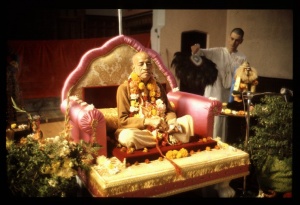CC Adi 1.68: Difference between revisions
m (1 revision(s)) |
No edit summary |
||
| Line 1: | Line 1: | ||
{{ | [[Category:Sri Caitanya-caritamrta - Adi-lila Chapter 01|C068]] | ||
<div style="float:left">'''[[Sri Caitanya-caritamrta|Śrī Caitanya-caritāmṛta]] - [[CC Adi|Ādi-līlā]] - [[CC Adi 1|Chapter 1: The Spiritual Masters]]'''</div> | |||
<div style="float:right">[[File:Go-previous.png|link=CC Adi 1.67|Ādi-līlā 1.67]] '''[[CC Adi 1.67|Ādi-līlā 1.67]] - [[CC Adi 1.69-70|Ādi-līlā 1.69-70]]''' [[File:Go-next.png|link=CC Adi 1.69-70|Ādi-līlā 1.69-70]]</div> | |||
{{CompareVersions|CC|Adi 1.68|CC 1975|CC 1996}} | |||
{{RandomImage}} | |||
==== TEXT 68 ==== | ==== TEXT 68 ==== | ||
<div | <div class="verse"> | ||
dui-rūpe haya bhagavānera prakāśa | :dui-rūpe haya bhagavānera prakāśa | ||
eke ta’ prakāśa haya, āre ta’ vilāsa | :eke ta’ prakāśa haya, āre ta’ vilāsa | ||
</div> | </div> | ||
| Line 12: | Line 16: | ||
==== SYNONYMS ==== | ==== SYNONYMS ==== | ||
<div | <div class="synonyms"> | ||
dui- | ''dui-rūpe''—in two forms; ''haya''—are; ''bhagavānera''—of the Supreme Personality of Godhead; ''prakāśa''—manifestations; ''eke''—in one; ''ta’''—certainly; ''prakāśa''—manifestation; ''haya''—is; ''āre''—in the other; ''ta’''—certainly; ''vilāsa''—engaged in pastimes. | ||
</div> | </div> | ||
| Line 19: | Line 23: | ||
==== TRANSLATION ==== | ==== TRANSLATION ==== | ||
<div | <div class="translation"> | ||
The Personality of Godhead exhibits Himself in two kinds of forms: prakāśa and vilāsa. | The Personality of Godhead exhibits Himself in two kinds of forms: prakāśa and vilāsa. | ||
</div> | </div> | ||
| Line 26: | Line 30: | ||
==== PURPORT ==== | ==== PURPORT ==== | ||
<div | <div class="purport"> | ||
The Supreme Lord expands His personal forms in two primary categories. The prakāśa forms are manifested by Lord Kṛṣṇa for His pastimes, and their features are exactly like His. When Lord Kṛṣṇa married sixteen thousand queens in Dvārakā, He did so in sixteen thousand prakāśa expansions. Similarly, during the rāsa dance He expanded Himself in identical prakāśa forms to dance beside each and every gopī simultaneously. When the Lord manifests His vilāsa expansions, however, they are all somewhat different in their bodily features. Lord Balarāma is the first vilāsa expansion of Lord Kṛṣṇa, and the four-handed Nārāyaṇa forms in Vaikuṇṭha expand from Balarāma. There is no difference between the bodily forms of Śrī Kṛṣṇa and Balarāma except that Their bodily colors are different. Similarly, Śrī Nārāyaṇa in Vaikuṇṭha has four hands, whereas Kṛṣṇa has only two. The expansions of the Lord who manifest such bodily differences are known as vilāsa-vigrahas. | The Supreme Lord expands His personal forms in two primary categories. The ''prakāśa'' forms are manifested by Lord Kṛṣṇa for His pastimes, and their features are exactly like His. When Lord Kṛṣṇa married sixteen thousand queens in Dvārakā, He did so in sixteen thousand ''prakāśa'' expansions. Similarly, during the ''rāsa'' dance He expanded Himself in identical ''prakāśa'' forms to dance beside each and every gopī simultaneously. When the Lord manifests His ''vilāsa'' expansions, however, they are all somewhat different in their bodily features. Lord Balarāma is the first ''vilāsa'' expansion of Lord Kṛṣṇa, and the four-handed Nārāyaṇa forms in Vaikuṇṭha expand from Balarāma. There is no difference between the bodily forms of Śrī Kṛṣṇa and Balarāma except that Their bodily colors are different. Similarly, Śrī Nārāyaṇa in Vaikuṇṭha has four hands, whereas Kṛṣṇa has only two. The expansions of the Lord who manifest such bodily differences are known as ''vilāsa-vigrahas''. | ||
</div> | </div> | ||
__NOTOC__ | |||
<div style="float:right; clear:both;">[[File:Go-previous.png|link=CC Adi 1.67|Ādi-līlā 1.67]] '''[[CC Adi 1.67|Ādi-līlā 1.67]] - [[CC Adi 1.69-70|Ādi-līlā 1.69-70]]''' [[File:Go-next.png|link=CC Adi 1.69-70|Ādi-līlā 1.69-70]]</div> | |||
__NOTOC__ | |||
__NOEDITSECTION__ | |||
Revision as of 17:57, 31 July 2021

A.C. Bhaktivedanta Swami Prabhupada
TEXT 68
- dui-rūpe haya bhagavānera prakāśa
- eke ta’ prakāśa haya, āre ta’ vilāsa
SYNONYMS
dui-rūpe—in two forms; haya—are; bhagavānera—of the Supreme Personality of Godhead; prakāśa—manifestations; eke—in one; ta’—certainly; prakāśa—manifestation; haya—is; āre—in the other; ta’—certainly; vilāsa—engaged in pastimes.
TRANSLATION
The Personality of Godhead exhibits Himself in two kinds of forms: prakāśa and vilāsa.
PURPORT
The Supreme Lord expands His personal forms in two primary categories. The prakāśa forms are manifested by Lord Kṛṣṇa for His pastimes, and their features are exactly like His. When Lord Kṛṣṇa married sixteen thousand queens in Dvārakā, He did so in sixteen thousand prakāśa expansions. Similarly, during the rāsa dance He expanded Himself in identical prakāśa forms to dance beside each and every gopī simultaneously. When the Lord manifests His vilāsa expansions, however, they are all somewhat different in their bodily features. Lord Balarāma is the first vilāsa expansion of Lord Kṛṣṇa, and the four-handed Nārāyaṇa forms in Vaikuṇṭha expand from Balarāma. There is no difference between the bodily forms of Śrī Kṛṣṇa and Balarāma except that Their bodily colors are different. Similarly, Śrī Nārāyaṇa in Vaikuṇṭha has four hands, whereas Kṛṣṇa has only two. The expansions of the Lord who manifest such bodily differences are known as vilāsa-vigrahas.